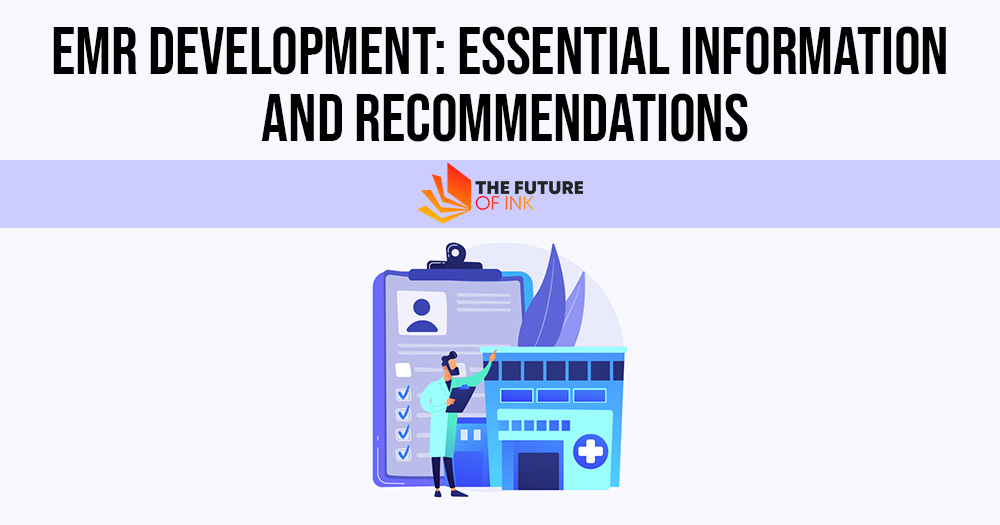In today’s hospitals, you want EMR software suited to your specific needs. A solution that satisfies a given set of requirements. As a result, your EMR software development process is more open to change and distinct from another.

However, there are a few crucial qualities to such a system’s basic structure.
Contents
Essential characteristics of the electronic health record systems
-
History and profile of the patient
Charting is most likely the most important aspect to create an EMR software. A platform should include a dignified place where doctors may keep track of their patient’s clinical data and their medical history, which should contain all pertinent information and details about their health issues.
Demographics, a patient’s location, vital signs, prescriptions, therapy, laboratory reports, and virtually anything else useful to a clinician are all examples of data.
Also Read: 5 Latest Trends For Your Company Blog
-
Order entry and e-prescribing
Treatment instructions or medical orders may be input and submitted online from inside the application. E-prescribing allows doctors to deliver prescriptions to pharmacies in the quickest possible time. It saves time and eliminates the risk of human mistakes.
Electronic prior approval, interactivity, event notifications, medicine choice help, and other features can be included in the module.
-
Scheduling appointments
Appointment scheduling is a basic yet important function in practice management software. It allows users to schedule appointments, see them on a calendar, manage waitlists and no-shows, and reschedule requests.
-
Dashboard for clinicians
Because it shows data on major practice performance measures, the dashboard gives a holistic perspective of one’s healthcare practice.
The data can be presented in a tabular or graphical manner for rapid practice analysis. This enables a clinician to spot any harmful trends promptly and take appropriate action.
-
Compliance Tracking
Healthcare is all about adhering to regulations. The platforms might include a feature that tracks core practice operations to verify that they are carried out in line with industry norms and laws.
-
Cloud-hosting
Healthcare providers may access their EMR/EHR through cloud hosting from any device, including their iPhone, iPad, Android smartphone, or any tablet or PC.
Cloud solutions enable practitioners to avoid upfront infrastructure expenditures and on-the-ground upkeep by making a platform transportable.
-
Management of tasks
The tool assists clinicians and physicians in condensing typical chores into an all-encompassing to-do list and providing a single, standardized point of access to any of their frequent actions – from issuing prescriptions to interacting with employees. Video, audio or text messaging, chat, and photos are all possible modes of communication.
-
Portal for self-service
Most platforms now have a separate patient site where patients may schedule appointments, connect with their doctors, obtain test results and medications, and make payments.
-
Accessible 24 hours a day, 7 days
Providing medical services comes with a slew of needs, including access to digital healthcare tools 24 hours a day, seven days a week.
Regardless of the time of day or week, the EHR/EMR should be able to respond to any immediate demands.
-
Access control based on roles
This feature grants access to all hospital managers, specialists, and physicians at their level, instantly increasing the tool’s privacy and security.
For your EMR system, further features and capabilities are available.
Aside from the essential functionalities, most EMRs and EHRs have several additional features. They give clinicians the information they need to make informed decisions regarding patient care.
-
Artificial intelligence is a type of artificial intelligence.
Artificial intelligence (AI)-based solutions have been shown to improve EHR usability. It aids in the improvement of processes and the accessibility of patient and problem-specific information at the point of care. Many EHRs, as you presumably know, require users to navigate through many screens to discover important data.
Inefficiencies like this can reduce clinician productivity and divert resources away from direct patient care. Organizations may increase the usability of their platforms by using AI-powered solutions.
They may utilize such technologies to swiftly discover and evaluate clinical data from a variety of sources, so improving patient care and reducing clinician frustration.
-
Internet of Medical Things
Throughout the healthcare industry, millions of IoT devices are distributed worldwide. Because of the various options in the medical field, the number continues to rise.
During therapy, doctors can connect various sensory devices to patients to monitor crucial indications such as heart rate, body temperature, and blood pressure in real-time. All of this data may be used to create EHRs and EMRs.
Also Read: Software Development for e-Commerce: 7 Amazing Facts to Know
-
Solutions provided by other parties
While system-wide interoperability enhancements may have to be postponed, healthcare providers can add third-party solutions to EHRs to enable the transmission and sharing of clinical data.
Applying mapping techniques to particular clinical ideas, for example, might result in medical information inside the EHR becoming standardized, allowing users to get rapid access to the data they require.
Whatever features your EMR/EHR platform may require, be sure they are developed by a software firm with a lot of expertise.




